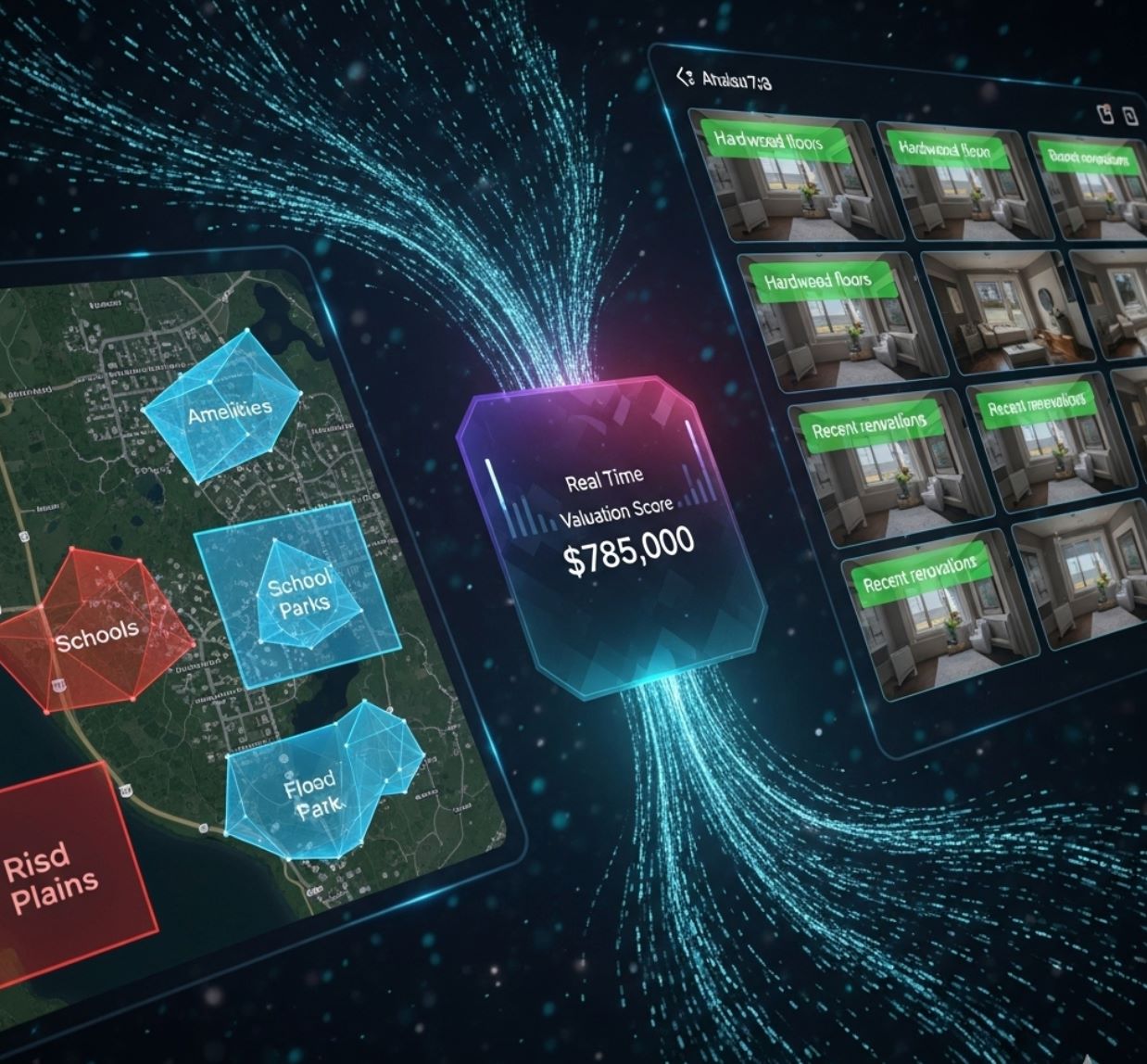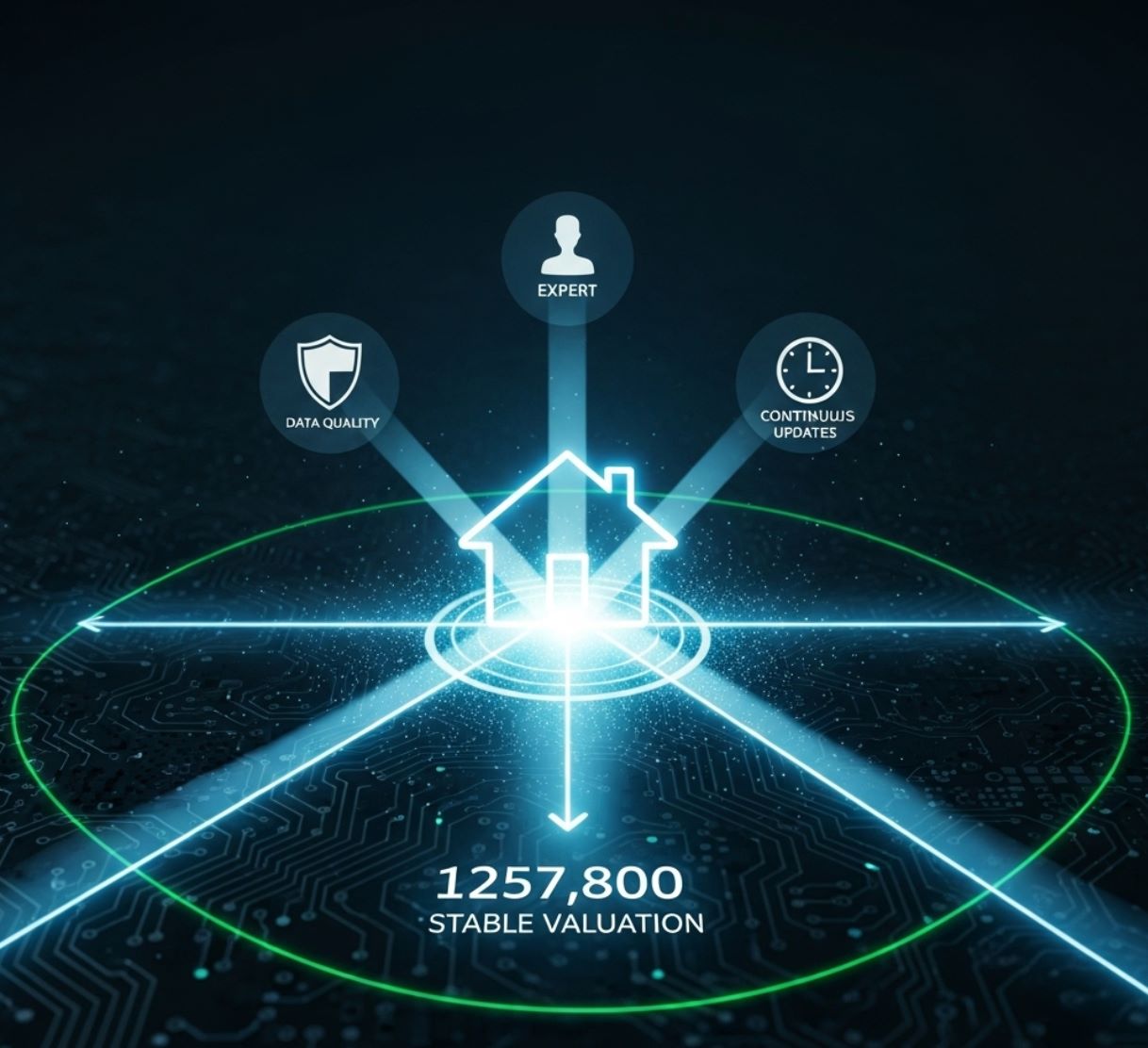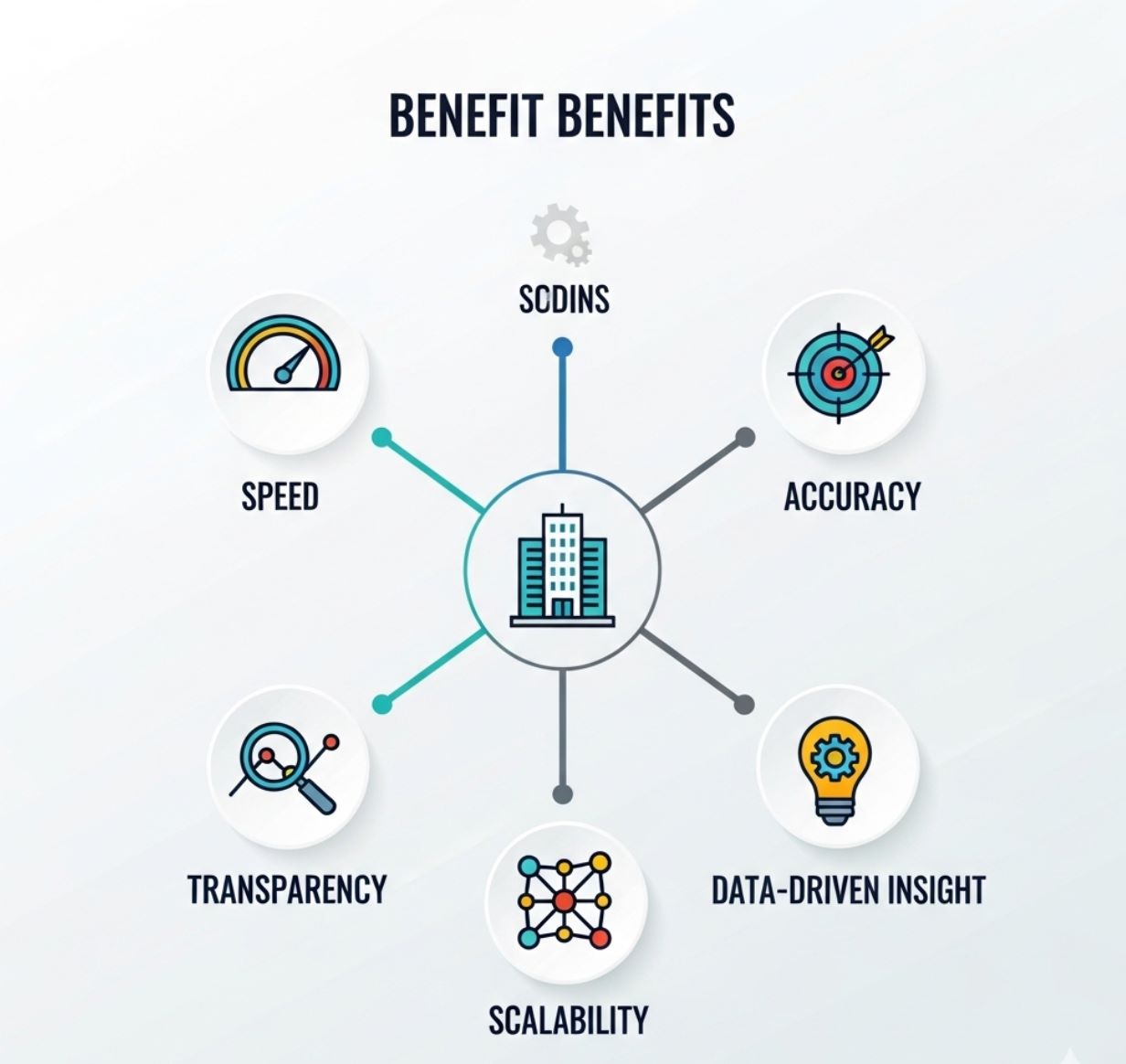AI Real Estate Valuation
Real estate valuation is a complex process influenced by factors such as location, size, amenities, and market fluctuations. Traditional methods are often time-consuming, subjective, and prone to inaccuracy. Today, AI is transforming property valuation by analyzing big data from past transactions, regional insights, and buyer behavior, delivering faster, more precise, and transparent estimates. This empowers investors, agents, and clients to make smarter, more efficient decisions.
The real estate industry is undergoing a revolution in how properties are valued. Traditionally, appraisals relied on expert judgment and sales comparables, a slow process prone to lagging market shifts.
Today, artificial intelligence (AI) enables automated valuation models (AVMs) that deliver instant price estimates by crunching massive datasets.
AVMs now give property owners and investors near-instant insight into asset values "as easily as any individual can check a bank account balance". This level of on-demand valuation was "next to impossible" in the past for illiquid real estate, but AI-driven analytics now provide timely, continuous updates on price changes.
— Major Real Estate Firms Industry Report
AI and the Rise of Automated Valuations
Automated valuation models (AVMs) powered by AI are already ubiquitous in home markets worldwide. Portals in Australia (REA), the UK (Rightmove) and the US (Zillow) each use AVMs to estimate home values by analyzing comparable sales.
These AI models often go far beyond what a human appraiser could process.
Neural Networks
Zillow's Zestimate leverages advanced neural network models for complex pattern recognition.
- County tax records
- MLS feeds integration
- Hundreds of property features
Massive Scale
Real-time valuation capabilities across entire markets.
- 116+ million U.S. homes
- Multiple weekly updates
- Continuous data refresh
High Accuracy
Remarkably precise results with minimal error rates.
- 1.83% median error
- Listed homes focus
- Real-time adjustments
Other providers use similar AI-driven approaches. Redfin's Estimate, CoreLogic's analytics tools and HouseCanary's platform all apply machine learning to large, real-time datasets.
In underwriting and lending, these tools bring instant, data-backed valuations that once took days or weeks.

Real-Time Data Integration with AI
AI-based valuations hinge on aggregating real-time data from many sources. With the click of a button, a modern AVM can pull together public property records, recent sales, tax assessments, market price trends, economic indicators and more – all in seconds.
Human Appraiser Process
- Manual data gathering
- Limited comparable analysis
- Days to weeks timeline
- Subjective interpretation
Automated AI Process
- Instant data aggregation
- Massive dataset analysis
- Seconds to minutes timeline
- Data-driven objectivity
No human appraiser could gather and process that much information so quickly.
Data Collection
The AI continuously ingests updated information (e.g. new listings, sale prices, tax data, interest rates).
Feature Analysis
Machine learning models analyze how factors like size, age, location, amenities and historical price trends relate to value.
Instant Output
The system delivers an updated price estimate (and confidence range) immediately.
These data pipelines are the first step to real-time valuation. AI tools can scrape online listings, public databases and even IoT or satellite feeds to keep the model's view of the market current.
For instance, a model might note a recent flood report affecting a neighborhood or a spike in local web searches for houses, and adjust valuations accordingly.
By contrast, traditional comps-based methods may rely on months-old sales and miss fast-moving trends.
Property Records & MLS Data
Economic & Market Trends
Geospatial/Environmental Data
User-Generated Signals
Each time the data pipeline runs, the valuation adjusts, effectively providing a "market snapshot" at that moment. Modern AVMs thus operate continuously, giving investors and lenders an always-updated view of asset values.

Geographic and Visual Data Enhancements
Beyond basic facts, AI valuation models now incorporate location and visual information to boost accuracy. Geospatial analysis (using GIS data) lets models factor in a property's surroundings – from proximity to transit and shops, to risks like flood zones or wildfire areas.
Cutting-edge systems also analyze images of the property. A landmark MIT study showed that AI could "see" qualities like interior design, curb appeal and renovation status from listing photos.
Location Intelligence
- Proximity to transit and amenities
- School district quality analysis
- Environmental risk assessment
- Neighborhood demographic trends
- Crime statistics and safety scores
Image Analysis Capabilities
- Interior design quality assessment
- Curb appeal scoring
- Renovation status detection
- Property condition evaluation
- Aesthetic appeal quantification
Enhanced Accuracy Results
The researchers trained a vision-language model to score each home's aesthetics and condition; adding those AI-generated image scores to traditional models significantly improved accuracy.
In practice, this means a well-staged, modern-looking home will get a higher estimate than an identical structure with outdated decor – reflecting buyer preferences that pure data might miss.
By quantifying visual appeal and neighborhood vibe, AI captures intangible value drivers that standard comps overlook.
Together, these enhancements give AI valuations a richer view of each property. They allow real-time adjustments for events like new infrastructure projects or sudden shifts in local sentiment.
In this way, models stay sensitive to the full context: not just square footage, but where and how the home exists.

Machine Learning Models Powering Valuation
Under the hood, AVMs use various machine learning algorithms – from regression models to ensembles (like gradient boosting) to deep neural networks – all trained on historical sales data.
Regression Models
Ensemble Methods
Neural Networks
These models learn complex correlations: for instance, how combinations of features and location history drive price. The more high-quality training data available, the better the model can predict.
In essence, the ML system identifies patterns in thousands or millions of past transactions and applies those to the property at hand.
New sales and listings become part of the training set, so the model adapts to, say, a sudden interest rate hike or demographic shift.
This "adaptive learning" ensures the valuation stays current even as old predictors lose relevance.
HouseCanary CanaryAI
Advanced platform for mortgage underwriters.
- Latest MLS integration
- Public data aggregation
- Real-time calculations
- What-if scenario analysis
Dynamic Capabilities
From static reports to interactive engines.
- Instant value updates
- Feature impact analysis
- Hypothetical modifications
- User query responses
For example, mortgage underwriters now use AI-augmented tools to speed decisions. Platforms like CanaryAI (HouseCanary) gather the latest MLS and public data to calculate home values in real time, letting lenders act on the freshest information.
They can also run what-if analyses, adjusting hypothetical features (like adding a bedroom) to see value impact. Overall, AI models have moved from static reports to dynamic valuation engines that respond instantly to new inputs and user queries.

Ensuring Accuracy in AI Valuations
Real-time AI estimates are powerful, but their accuracy depends on robust methods and data quality. Key practices include:
Continuous Updates
Leading AVMs recalculate values automatically whenever new data arrives.
- Zillow refreshes all Zestimates multiple times each week
- Major model upgrades roll out regularly
- Valuations reflect the latest market pulse, not outdated comps
- Real-time market condition adjustments
High-Quality Data Inputs
The accuracy of an AVM is only as good as its data. Incomplete or stale records can mislead models.
- Validate and cross-check data sources
- Match tax records to current listings
- Avoid "garbage in, garbage out" scenarios
- Continuous data quality monitoring
Human Oversight & Expertise
Even with AI's scale, human expertise remains critical. Models may miss qualitative factors like historical significance or unique architecture.
Automated Analysis
- Massive data processing
- Pattern recognition
- Speed and scale
- Consistent methodology
Qualitative Assessment
- Historical significance
- Unique architecture
- Market nuances
- Contextual judgment
Diverse Data Sources
Incorporating multiple data types (structured, geospatial, visual, social) helps the model generalize better.
Structured Data
Geospatial Data
Visual Data
IoT & Social Data
Modern AVMs weave together public records, drone or street images, and even IoT sensor data to create a 360° view. By fusing these inputs, AI can guard against missing signals – a strategy MIT researchers highlighted as raising model accuracy.
Together, these steps help minimize errors. When AI models are continuously tested and tuned, combined with expert review, they achieve impressive precision.
For example, AI-augmented models in a recent study explained 89% of sale price variance – well above traditional hedonic models – by capturing more of what buyers value.

Benefits for Industry Stakeholders
AI-powered real-time valuations offer clear advantages across real estate. Key benefits include:
Speed
Instant estimates replace time-consuming appraisals.
- Seconds vs. weeks timeline
- Accelerated underwriting
- Faster decision-making
- More responsive service
Accuracy
AI models often outperform traditional methods.
- Vast dataset analysis
- Low error rates (~1.8%)
- Precise results delivery
- Buyer/seller confidence
Transparency
Continuous valuation feeds for ongoing monitoring.
- Real-time portfolio tracking
- Early trend detection
- Market downturn alerts
- Predictable pricing
Scalability
Simultaneous valuation of thousands of properties.
- Portfolio-wide automation
- Institutional investor tools
- MLS platform integration
- Democratized access
Investors "have an opportunity to understand the value of their portfolio all of the time, whenever they want." This lowers risk by making pricing more predictable.
— Real Estate Industry Expert
Mortgage & Lending Benefits
- Faster underwriting decisions
- Real-time collateral assessment
- Risk reduction through data accuracy
- Automated portfolio monitoring
- Regulatory compliance support
Investment & Portfolio Management
- Continuous portfolio valuation
- Market trend identification
- Risk assessment automation
- Investment opportunity analysis
- Performance tracking
Sales & Marketing Advantages
- Instant pricing guidance
- Renovation impact analysis
- Competitive market analysis
- Client education tools
- Negotiation support data
This richness allows sharper negotiation and marketing strategies. Sellers learn how much curb appeal or a new kitchen remodel could add in real dollars, thanks to AI scoring of images and features.
In sum, AI real-time valuations are reshaping the market. They give professionals and consumers alike instant, evidence-based pricing information, making transactions faster and fairer.
Advanced AI – by combining huge data with machine learning – is making real-time property valuation "not just a possibility but a robust and reliable reality".
— Industry Research Report

Future Outlook
The capabilities of AI in real estate are still expanding. As more property data (including international markets) becomes available, models will improve even further.
Vision-Language AI
Buyer Psychology
Global Expansion
Research into vision-language AI and other novel methods promises to bring valuations closer to the subjective "buyers' minds" – quantifying aesthetics and buyer sentiment in ways that traditional math couldn't.
Current State
Real-time valuations with high accuracy
Near Future
24/7 valuation feeds as standard
Long Term
Fully automated market ecosystem
Ultimately, professionals expect a future where 24/7 valuation feeds are the norm. Property owners and investors will have the same kind of dynamic net-worth tracking for real estate that people already enjoy in their banking apps.
Automated Portfolio Rebalancing
Real-time adjustments based on current market valuations.
- Dynamic asset allocation
- Risk management automation
- Performance optimization
Dynamic Loan Pricing
Interest rates adjusted based on up-to-date collateral values.
- Real-time risk assessment
- Competitive rate adjustments
- Market-responsive lending
This shift will open new efficiencies: for example, automated portfolio rebalancing or dynamic loan pricing based on up-to-date collateral values.
The result is a more efficient market where decisions – buying, selling, lending or renovating – are guided by continuous, data-backed insight.

This empowers stakeholders – from agents and appraisers to individual homeowners and investors – to make smarter, faster decisions.
As the technology matures and data becomes ever richer, real estate valuation is set to become more precise, efficient and democratized than ever before.




